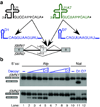Recognition of atypical 5' splice sites by shifted base-pairing to U1 snRNA
- PMID: 19169258
- PMCID: PMC2719486
- DOI: 10.1038/nsmb.1546
Recognition of atypical 5' splice sites by shifted base-pairing to U1 snRNA
Abstract
Accurate pre-mRNA splicing is crucial for gene expression. The 5' splice site (5' ss)--the highly diverse element at the 5' end of introns--is initially recognized via base-pairing to the 5' end of the U1 small nuclear RNA (snRNA). However, many natural 5' ss have a poor match to the consensus sequence, and are predicted to be weak. Using genetic suppression experiments in human cells, we demonstrate that some atypical 5' ss are actually efficiently recognized by U1, in an alternative base-pairing register that is shifted by one nucleotide. These atypical 5' ss are phylogenetically widespread, and many of them are conserved. Moreover, shifted base-pairing provides an explanation for the effect of a 5' ss mutation associated with pontocerebellar hypoplasia. The unexpected flexibility in 5' ss-U1 base-pairing challenges an established paradigm and has broad implications for splice-site prediction algorithms and gene-annotation efforts in genome projects.
Figures





References
-
- Brow DA. Allosteric cascade of spliceosome activation. Annu. Rev. Genet. 2002;36:333–360. - PubMed
-
- Bessonov S, Anokhina M, Will CL, Urlaub H, Lührmann R. Isolation of an active step I spliceosome and composition of its RNP core. Nature. 2008;452:846–850. - PubMed
-
- Lerner MR, Boyle JA, Mount SM, Wolin SL, Steitz JA. Are snRNPs involved in splicing? Nature. 1980;283:220–224. - PubMed
-
- Zhuang Y, Weiner AM. A compensatory base change in U1 snRNA suppresses a 5' splice site mutation. Cell. 1986;46:827–835. - PubMed
Publication types
MeSH terms
Substances
Grants and funding
LinkOut - more resources
Full Text Sources

